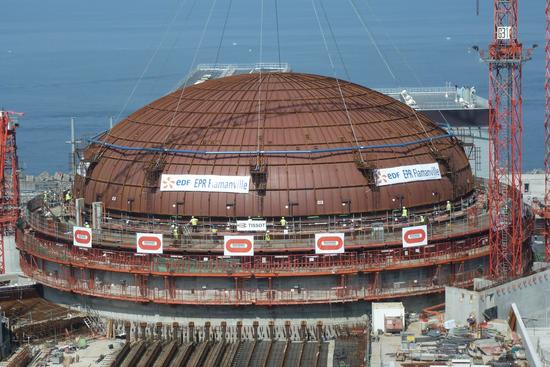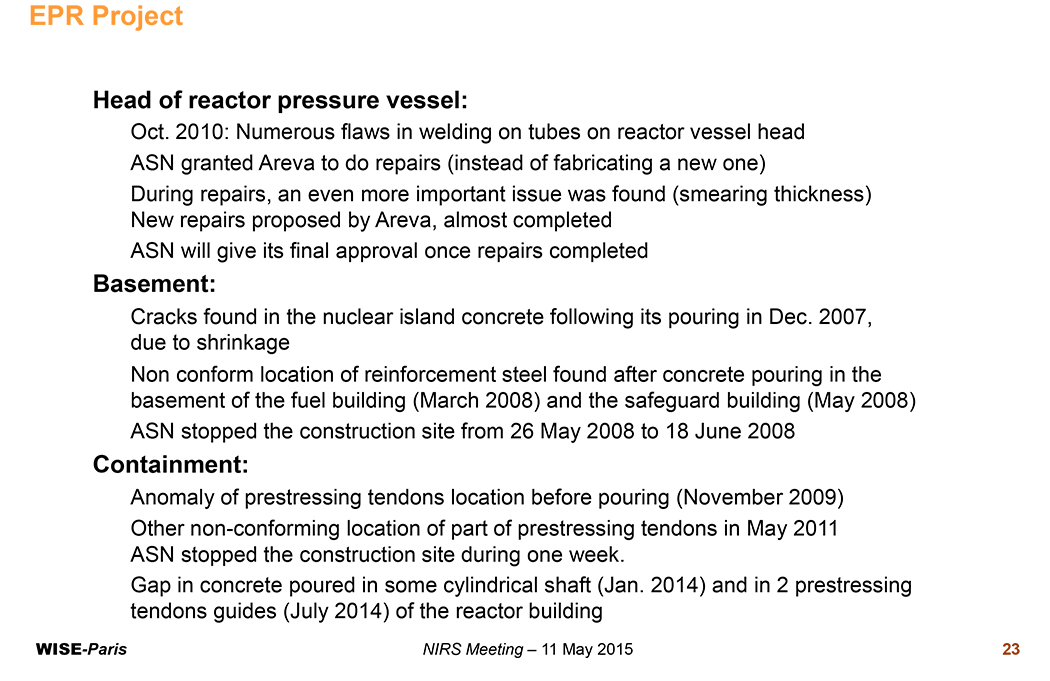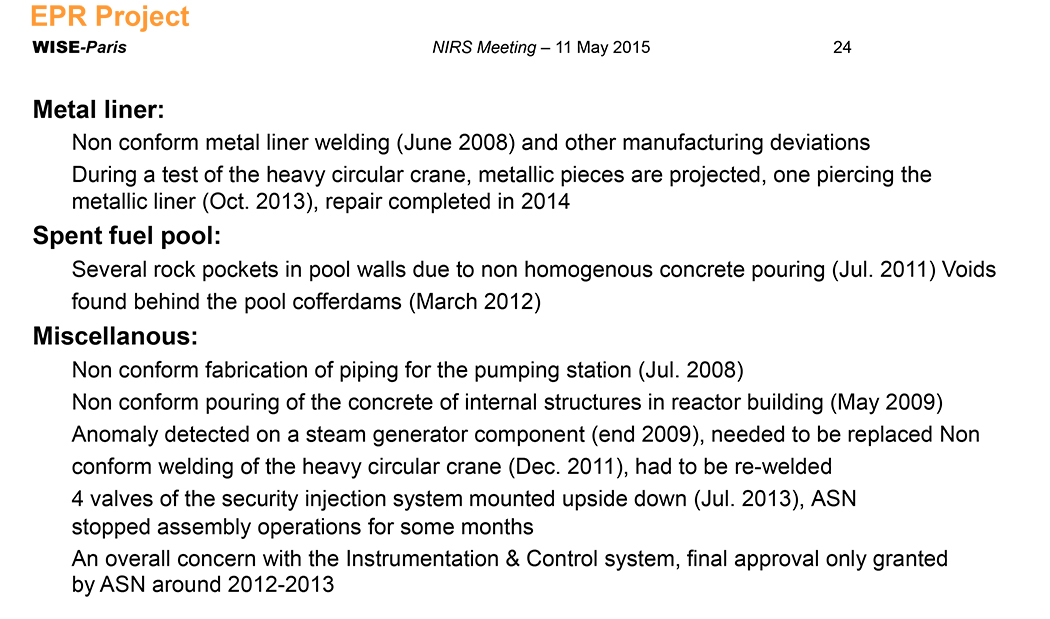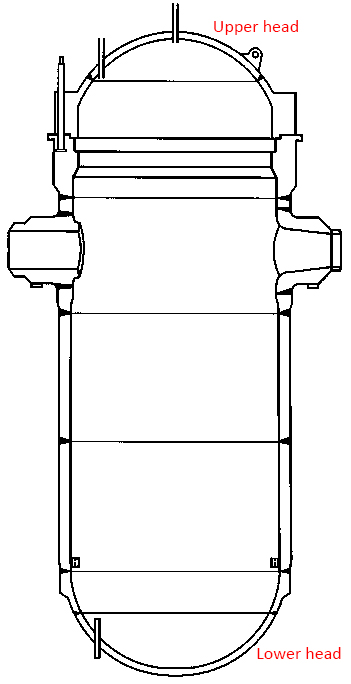
For most people with any interest in energy issues, France is synonymous with nuclear power. With 78% of its electricity generated by the atom, it is by far the most nuclear-dependent country in the world. It’s state-owned flagship Electricite de France is the world’s largest nuclear utility. State-owned Areva is one of the largest nuclear reactor manufacturers in the world.
When nuclear industry lobbyists–anywhere in the world–try to find a success story for their technology, they invariably point to France.
But more rapidly than could have been imagined even five years ago, pointing a finger at France doesn’t evoke nuclear success. Rather, France, whose nuclear industry is in speedy and accelerating decline, today exemplifies the failure of nuclear power. Moreover, a closer look at France reveals where the world is headed: to a clean and surprisingly affordable nuclear-free and carbon-free energy system.
If that kind of energy future can come to France–and it increasingly appears that it will and sooner than might be expected–then it can come everywhere.
Yves Marignac of WISE-Paris, whose expose of the current serious safety issues of Areva’s EPR reactors was published in GreenWorld a month ago, stopped by NIRS’ office this week and gave a presentation on recent developments in the French nuclear industry. This piece is based on that presentation and our ensuing discussion on the issues raised.
To understand just how far the French nuclear industry has fallen in recent years, look no further than the value of EDF and Areva. Since 2007, EDF’s stock price has fallen more than 70%; Areva’s by more than 85%. EDF is 34.2 Billion Euros in debt. Areva’s debt is much smaller, at 5.8 Billion Euros, but Areva is valued at only 3 Billion Euros (less than a third of the cost of the Flamanville or Finland’s Okiliuoto-3 EPRs now under construction). Last year, it lost 4.8 Billion Euros. If Areva weren’t 83% government-owned, it almost certainly would have declared bankruptcy by now.
Not only has Areva lost billions on the Finnish reactor–it is building the facility under a 3.3 Billion Euro fixed-price contract although the plant is now near the 9 Billion Euro mark, and counting–it is also losing money in its once lucrative reprocessing business and can’t find any new customers, and somehow even screwed up a radioactive waste storage contract at Chernobyl (link in French).
Areva’s problems appear to stem from a combination of incompetence and overreach–the EPR reactor is much larger than all but a very few potential customers can possibly use and so complex that it is proving nearly impossible–and hugely expensive–to build. Add to that the reality that much of the world is turning away from nuclear in the wake of Fukushima and the future seems dim for Areva as a reactor manufacturer. The company does have some potential viable businesses in uranium enrichment, radioactive waste management and nuclear services, but little else. And, if one wants to take a full measure of Areva’s incompetence, consider that it recently dropped, as a cost-cutting measure, its wind power business–probably the only potential growth area for the company.
EDF’s problems, although not as severe as Areva’s–mostly because it is much larger and as the main electric utility in France at least has cash flow–may be structurally even greater.
The basic issue is, as is the case for U.S. nuclear utilities like Exelon and Entergy, that EDF can no longer sell electricity for as much as its aging fleet of reactors cost to generate that electricity. As in the U.S., EDF’s operating and maintenance costs for its reactors are increasing at about 5% per year–and its electricity rates aren’t. Nor can it easily raise its rates: there are legal issues involved for its regulated business and if it raises rates in its deregulated markets it won’t be able to compete.
But the worst may be yet to come. Unlike in the U.S., where the Nuclear Regulatory Commission has been inclined to abandon nearly all of its originally-proposed post-Fukushima safety upgrades under industry pressure, French regulators have taken Fukushima seriously, and EDF will have to make major upgrades to its reactors if it wants to keep operating them. Add to that the fact that EDF’s reactors will begin reaching the end of their 40-year license period at the end of this decade, and the utility is looking at a cost estimated at about $110 Billion just to keep its existing reactors operating.
That’s money that will be nearly impossible for EDF to recover from ratepayers. Despite these existing and upcoming financial pressures, the French government’s only solution to Areva’s more immediate problems seems to be to have EDF buy out and take over Areva’s reactor business. That would leave Areva a shadow of its former self, relegated to the uranium enrichment, radioactive waste, and nuclear services businesses. It would leave EDF with potential exposure to even greater losses, especially if it turns out–as seems increasingly possible–that the EPR design is simply unbuildable at any rational cost.
There is now much more to the story of the current EPR problems than we published last month. The problem started when Areva recently reported that an “anomaly” was recently found in the upper and lower heads of the EPR pressure vessel for France’s Flamanville reactor now under construction by EDF.

First, check the slides to the right (numbers 23 and 24 in the full presentation): two full pages of other problems that have occurred with the EPR design and its construction at Flamanville. It’s little wonder that Flamanville is now 2 1/2 times over budget and five years behind schedule–and is likely to fall further behind, if it can even be completed at all, because of the “anomaly.”
Unlike the main part of the pressure vessel, which was forged at Japan Steel Works, the upper and lower heads of the Flamanville EPR were forged at Areva’s facility at Le Creusot, France. This was done back in 2006, even before the construction license was granted, but a year after Areva agreed to meet new regulations from the French nuclear regulator, ASN, about testing the vessel would have to undergo.

In September 2012, Areva proposed to ASN that the tests include a destructive testing program, which would entail taking pieces out of a separate vessel to determine whether the forging had been done properly. The Flamanville vessel was welded into place beginning in January 2014. The destructive testing was conducted in October 2014.
As a side note, for those of us in the U.S. and especially those involved (as we were) in fighting the proposed Calvert Cliffs-3 EPR reactor in Maryland, it appears that the destructive tests Areva conducted were done on the heads of the vessel originally manufactured for that site–certainly the final nail in that long-buried coffin.
The tests confirmed that the fabrication of the vessel heads, presumably both upper and lower heads, was flawed. The upper head, for which access is still possible, potentially could be replaced if further tests find that is required. But replacing the lower head, which has been welded to the bottom of the emplaced vessel, would be just about impossible. It likely would be cheaper to simply replace the entire vessel than try to undertake such an operation–and that would be an extraordinary cost.

Areva and EDF will certainly try to convince French regulators to allow the reactor to be licensed despite the problems with the vessel heads. If they are unsuccessful, it is nearly certain that the Flamanville project will be abandoned. Even if ultimately successful in that plea, it will be many months–possibly a year or more–before there is a resolution to the issue, and in the meantime the costs, and cost overruns and schedule delays, just keep mounting.
When first proposed, EDF said the reactor would provide power at 28.4 Euros per Megawatt/hour of electricity generated. That figure is now up to 90 Euros per Megawatt/hour, and still growing–well above any rate EDF could actually charge for power from the reactor.
Flamanville (and Calvert Cliffs-3) are likely not the only reactors affected, however. China’s two Taishan EPRs, which are nearly complete and supposedly just about ready for hot testing, may suffer from the anamoly too. Given their more advanced stage of construction, replacement of the heads would almost certainly be impossible. Either the Chinese would have to let the reactors operate anyway, perhaps by giving them some sort of exception from the regulations, or they would have to abandon the project. Given the lack of transparency in Chinese nuclear matters, it is impossible to know what is most likely to happen, although news reports have indicated start-up will not be allowed until more testing information from Areva is available.
The other, highly controversial, reactor that may be affected because its vessel heads already have been manufactured at Le Creusot, is the proposed Hinkley Point C reactors in the U.K. Although that project has not even begun, and EDF has not yet found sufficient foreign (read: Chinese) investors to make the project feasible despite the British government’s promise of taxpayer subsidies so that EDF will receive an incredible 110 Euros per Megawatt/hour generated. Those promised subsidies are being taken to court by Austria and Luxembourg as violations of European Union law–a case that could further delay Hinkley Point in any case. Already, even before official groundbreaking, the Hinkley Point project is projected to cost as much as $25 Billion.
The Fukushima disaster may not have done much to change U.S. government policy on nuclear power, but across the rest of the world it was taken seriously. Germany, of course, accelerated its Energiewende energy transition program, which will lead to the shutdown of all of its reactors by 2022 and their replacement by clean renewable energy and energy efficiency.
What has gone less noticed is that France is beginning its own energy transition that is, in absolute terms, just as aggressive as Germany’s.
The transition began when Francois Hollande was elected President in May 2012 and not long afterward called for a goal of reducing French reliance on nuclear power to 50% by 2025. In terms of numbers of reactors, getting France down to 50% from 78% means closing about the same number of reactors–perhaps even a couple more–as Germany will in getting its nuclear generation from 19% to zero.
As in Germany, the idea is that France should replace these reactors with clean energy and efficiency, not more fossil fuels. As Hollande said during the presidential campaign, it is time for France to end its “double dependency” on both oil and nuclear power. In the past, nuclear had been held up as the answer to dependency on oil. No longer.
But in France, unlike in Germany where a strong anti-nuclear consensus already existed, nuclear power has historically had a lot of public, and trade union, support. So the government didn’t simply decree its goals on reducing reliance on nuclear. Instead, it set up a national debate on the energy transition, bringing together energy experts, unions, utility officials and lobbyists, environmentalists and clean energy activists, and the general public to try to come up with an energy policy that both works and will help address the climate crisis.
While the “national debate” wasn’t perfect–some say the government could have done more and spent more on advertising and outreach to ensure the broadest possible public involvement and understanding of the issues–the outcome, which is now in a draft bill before the French Parliament–appears to have broad support.
It calls, as Hollande proposed, for reducing French reliance on nuclear to 50% by 2025. Fossil fuels would be cut by 30% by 2030. Renewables would increase by 32% and overall energy use would drop by 20% (and drop by 50% by mid-century), achieved primarily by increasing energy efficiency. The Parliament is expected to approve the policy next month.
There remain major questions about implementation of the transition. So far, the only nuclear shutdown commitment is for two old reactors at Fessenheim next year. And there is no legally-enforceable means for the government to force additional shutdowns (although there is a cap on the amount of nuclear generation set at the current level, meaning that if EDF wants to add a reactor, like Flamanville, to the grid it will have to close an equal megawattage of existing reactors). But clean energy activists did succeed in assuring legal intervention possibilities for all proposed license extensions. And the intent of the transition is clear even if the mechanics are not.
What is almost unimaginable to us in the U.S. is the entire idea of a “national debate on the energy transition.” Even if it weren’t done perfectly, and it wasn’t, the idea of bringing in the public to help set a national policy on energy and climate would be groundbreaking and breathtaking. After all, as we’ve pointed out here repeatedly, the U.S. public wants more solar, wind and efficiency and less nuclear, oil and coal. The idea of putting the public in the driver’s seat is just wistful fantasy here, unfortunately. One can only look overseas with envy.
After the French debate was completed and put into legislative form, however, a new report leaked out. The government tried briefly to prevent its release, but that didn’t work. The report shows that France–like just about every other nation in the world–can get to 100% renewables by 2050, and can do so affordably. Indeed, it would cost virtually no more, and perhaps even less, than keeping nuclear at 50% of French generation. The study, which still isn’t “officially” released pending more government review, is so far available only in French, although slide 12 of Yves Marignac’s presentation gives a basic summary of its findings: going to the 100% renewable mix described would cost about 120 Euros/megawatt hour in 2050; only slightly more than keeping renewables at 40%, which would cost about 118 Euros megawatt/hour. Given that renewables are expected to further drop in cost, and back-up storage prices are dropping rapidly (as the recent Tesla announcements indicate) there is good reason to believe that costs for the 100% renewable option are somewhat overstated and that they would in reality be lower.
France is at a crossroads. Its nuclear flagships EDF and Areva are in shambles and facing decades of ever-rising costs. Public concern about nuclear accidents remains high in the wake of Fukushima and dealing with radioactive waste is a problem as intractable in France as it is in the U.S. Meanwhile, the energy path to the future is becoming clearer and clearer. If France can successfully manage the first phase of their transition–the part that reduces nuclear to 50% of French generation–it will have shown the world an accomplishment as meaningful as Germany’s transition and demonstrated that every country can move to a clean energy system.
It may not be long before the people pointing at the French energy system are clean energy advocates, not nuclear industry lobbyists who will have lost their last role model.
Michael Mariotte
May 14, 2015
Permalink: https://www.nirs.org/2015/05/14/the-accelerating-decline-of-french-nuclear-power/
Your contributions make publication of GreenWorld possible. If you value GreenWorld, please make a tax-deductible donation here and ensure our continued publication. We gratefully appreciate every donation of any size.
Comments are welcome on all GreenWorld posts! Say your piece. Start a discussion. Don’t be shy; this blog is for you.
If you’d like to receive GreenWorld via e-mail, send your name and e-mail address to nirs@nirs.org and we’ll send you an invitation. Note that the invitation will come from a GreenWorld@wordpress.com address and not a nirs.org address, so watch for it. Or just put your e-mail address into the box in the right-hand column.
If you like GreenWorld, help us reach more people. Just use the icons below to “like” our posts and to share them on the various social networking sites you use. And if you don’t like GreenWorld, please let us know that too. Send an e-mail with your comments/complaints/compliments to nirs@nirs.org. Thank you!
GreenWorld is crossposted on tumblr at https://www.tumblr.com/blog/nirsnet




If your goal is to reduce carbon, why on earth would you prematurely shut down large sources of low-carbon energy, unless you have a 100% renewable system ready to switch over to? Otherwise you are not achieving the maximum carbon reductions possible.
Getting to 100% renewables by 2050 is simply too late – you need a very low carbon (<50gCO2e/kWh) energy system in place by 2030 to stand a fair chance of staying under 2 degrees – so 100% renewables would appear too late to provide this.
Ruling out one significant source of low-carbon energy in this scenario seems a bit daft.
We have answered variations of this question repeatedly on this site, both in comments and in posts. It is impossible to implement 100% renewables with any significant amount of nuclear power. Switching to renewables necessitates a nimble, responsive grid that can handle the variations in power output that are normal with large-scale renewable generation. Nuclear reactors (and coal plants, for that matter), which provide only “baseload” power, cannot ramp their power levels up and down quickly in response to changing conditions. Thus, they (and the entire 20th century concept of “baseload” power) become obsolete in a renewable-powered energy system. We are, in the U.S., not yet at the point where this is a serious problem for the grid, but some European countries already are at that point. But at current rates of expansion, we are getting to that point far faster than imagined even ten years ago. As renewable penetration increases, nuclear/coal generation will have to decrease.
Of course, there are many other reasons to close nuclear reactors–carbon is not the only evil in the world. Closing uneconomic reactors makes sense from a cost perspective. Closing reactors alleviates safety concerns and prevents additional radioactive waste generation–for which no country in the world has yet implemented a permanent solution (Finland is closest, and they’re not there yet, and nobody else is even close). Closing reactors also prevents additional and environmentally-destructive uranium mining, and the creation of vast quantities of radioactive/hazardous waste produced by uranium processing, enrichment and fuel fabrication.
Nuclear reactors (and coal plants, for that matter), which provide only “baseload” power, cannot ramp their power levels up and down quickly in response to changing conditions.
actually there are nuclear reactors including some in france that are designed to be load following. They cost more since they dont sell all their electricity all the time but they exist
No, that doesn’t exist. Nuclear reactors cannot power up and down fast enough to operate effectively in a grid dominated by variable generation sources. That’s physics, not intention. If they could, you would certainly see the nuclear industry trying to sell that point right now–it would be very helpful to them. But they can’t.
This is great news! What will happen when those companies are all bankrupt and still have to pay so much more in order to decommission those plants and isolate the radioactivity from the environment. Just shutting down power plants isn’t enough – who is going to pay for it? Watch the cost of the megawatts skyrocket – and in the end it is the people who will essentially have to pay for the government’s attempts to kill the people.
Fascism – what we see across the world every place the insidious nuclear industries have been accepted by governments. America has fallen completely. Fascism has completely taken over here. We no longer live under democratic rule. The Founders were careful to craft the Law of the Land to prohibit this kind of takeover. The Constitution and Bill of Rights has been ignored for decades. At least affirmative actions are finally being taken in other parts of the world where the voice of the citizen can still be heard.
“Fascism” is a strong word and, frankly, it is on the verge of ridiculous to call the U.S. a “fascist” country. Do nuclear power utilities have a lot of political power? Yes. But so does the public. Nuclear power is diminishing in the U.S. and elsewhere because of poor economics, a poor safety record–and public pressure. Elections matter–and those are inherently not fascist. So does grassroots organizing and action–essentially prohibited in fascist societies. A fascist nation might well prohibit publication of GreenWorld…..we don’t feel in any particular danger by continuing to produce it….
Whew !!! Thank you Michael for getting ShannYn straightened out there